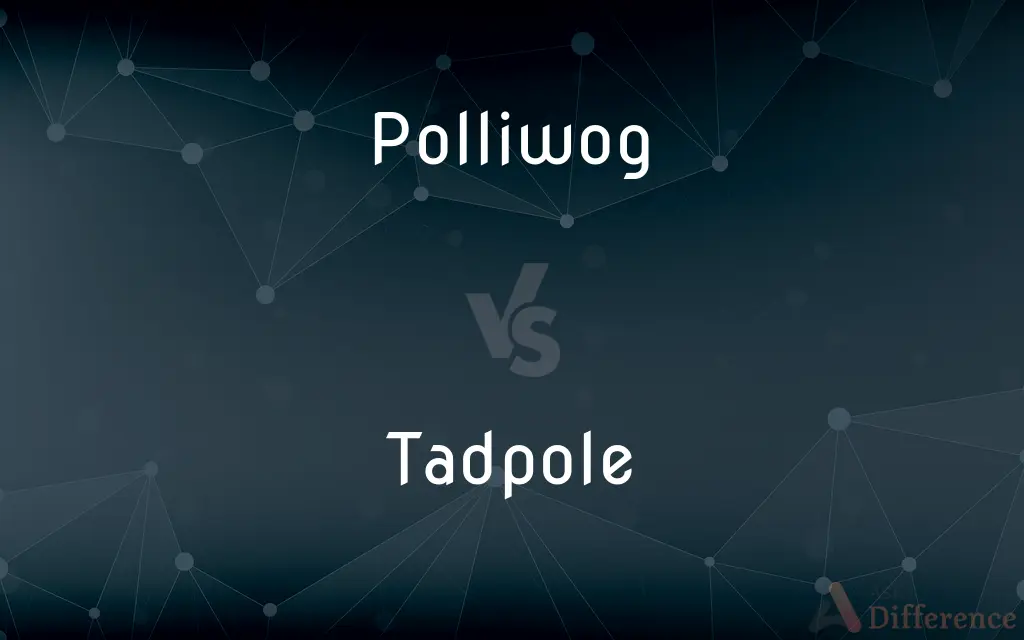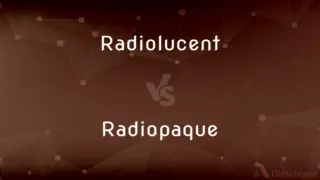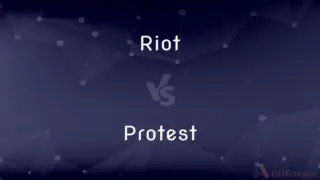Polliwog vs. Tadpole — What's the Difference?
Edited by Tayyaba Rehman — By Fiza Rafique — Updated on November 3, 2023
Polliwog and tadpole both refer to the larval stage of a frog or toad; they are synonymous with regional variation—'polliwog' is more colloquial and 'tadpole' is more scientific.

Difference Between Polliwog and Tadpole
Table of Contents
ADVERTISEMENT
Key Differences
Polliwog is a term that harks back to Middle English, potentially coming from "poll," meaning head, and "wiglen," meaning to wiggle, referencing the head-wiggling motion of the larva. Tadpole, on the other hand, may derive from "tadde," meaning toad, and "pol," meaning head, denoting the early, head-dominated form of these amphibians. Both words describe the same organism in its juvenile, aquatic stage, where it breathes through gills and does not resemble the adult frog or toad.
The word polliwog is a more whimsical and less formal term compared to tadpole. Polliwog is commonly used in colloquial American English, particularly in the United States. Tadpole, however, is universally recognized and used across the English-speaking world, including in scientific and educational contexts, giving it a more official standing.
In literature, polliwog can often be found in children's books, poems, and songs due to its playful sound and ease of rhyme. Tadpole is used in textbooks, academic papers, and documentaries, serving as the standard term for the larval stage of amphibians in biology.
Both polliwog and tadpole encapsulate a stage of metamorphosis, embodying the transformation from the water-bound creature to a land-dwelling frog or toad. The usage of polliwog vs. tadpole does not change this biological fact; it merely reflects a preference in vernacular or formality.
Regardless of whether one uses polliwog or tadpole, both words convey a sense of growth and development. These terms remind us of the remarkable journey these creatures undertake, evolving from swimming larvae to jumping amphibians, a transformation that has fascinated humans for centuries.
ADVERTISEMENT
Comparison Chart
Etymology
"Polliwog" is derived from Middle English, possibly from "poll" (head) and "wiglen" (to wiggle).
"Tadpole" comes from Middle English, from "tadde" (toad) and "pol" (head).
Usage
More colloquial and regional, commonly used in American English.
More formal and scientific, widely used in international English.
Context
Often found in children’s literature and casual speech.
Used in scientific discourse and formal education.
Phonetics
"Polliwog" has a playful, whimsical sound that can appeal to children.
"Tadpole" has a more straightforward and clinical sound.
Cultural Connotation
"Polliwog" conveys a quaint, old-fashioned feeling.
"Tadpole" is more modern and neutral in connotation.
Compare with Definitions
Polliwog
A young amphibian.
The polliwog wriggled through the pond’s murky water.
Tadpole
Young frog or toad.
Tadpoles cluster in the shadows of the lily pads.
Polliwog
Frog or toad larva.
In spring, the creek is full of polliwogs.
Tadpole
An amphibian larva.
The tadpole has just sprouted its hind legs.
Polliwog
Aquatic larval stage.
Observing a polliwog's development helps students understand metamorphosis.
Tadpole
A tadpole is the larval stage in the life cycle of an amphibian. Most tadpoles are fully aquatic, though some species of amphibians have tadpoles that are terrestrial.
Polliwog
A creature with gills and tail.
The children watched in fascination as the polliwog used its tail to swim.
Tadpole
The aquatic larva of a frog or toad, having gills, a long, laterally compressed tail, and in early stages, no limbs. During metamorphosis of a tadpole into an adult, legs and lungs develop, and the tail gradually disappears. Also called polliwog.
Polliwog
Metamorphosing amphibian.
A polliwog will eventually grow legs and lose its tail.
Tadpole
A young toad or frog in its larval stage of development that lives in water, has a tail and no legs, and, like a fish, breathes through gills.
Polliwog
See tadpole.
Tadpole
(by extension) The aquatic larva of any amphibian.
Salamander tadpole
Polliwog
A tadpole.
Tadpole
A type of cargo bike that has two wheels in front and one in back.
Polliwog
A larval frog or toad
Tadpole
(psychology) A child's basic drawing of a human being, having a detailed head but only sticks for the body and limbs.
Tadpole
(informal) A small child.
Tadpole
The young aquatic larva of any amphibian. In this stage it breathes by means of external or internal gills, is at first destitute of legs, and has a finlike tail. Called also polliwig, polliwog, porwiggle, or purwiggy.
Tadpole
The hooded merganser.
Tadpole
A larval frog or toad
Tadpole
Gilled aquatic creature.
The tank was teeming with tadpoles of various sizes.
Tadpole
A developing frog.
Over time, the tadpole will lose its tail as it matures.
Tadpole
Early life stage.
Studying a tadpole offers insight into amphibian biology.
Common Curiosities
Is polliwog a scientific term?
No, polliwog is considered more colloquial, while tadpole is the scientific term.
What is a polliwog?
A polliwog is the larval stage of a frog or toad.
Are polliwogs and tadpoles the same thing?
Yes, polliwog and tadpole are two terms for the same amphibian larva.
Do both polliwogs and tadpoles have tails?
Yes, both have tails which they use for swimming.
What does a tadpole turn into?
A tadpole metamorphoses into an adult frog or toad.
Why is it less common to hear 'polliwog' in a biology class?
In formal education, 'tadpole' is preferred for scientific consistency.
Can you find polliwogs in any body of freshwater?
Polliwogs can be found in most freshwater habitats where frogs and toads breed.
What do polliwogs eat?
Polliwogs typically eat algae and plant matter.
Is the term tadpole used worldwide?
Yes, 'tadpole' is recognized and used globally in the English-speaking world.
Do tadpoles have predators?
Yes, tadpoles are preyed upon by fish, birds, insects, and even other amphibians.
How long does it take for a tadpole to become a frog?
It can take anywhere from a few weeks to several months for a tadpole to become a frog, depending on the species.
Are the terms polliwog and tadpole used interchangeably in literature?
Yes, authors may use both terms interchangeably, depending on their stylistic preference.
When do tadpoles start breathing air?
Tadpoles develop lungs as they mature and will start breathing air when they are partially developed frogs.
Can the word polliwog be used in formal writing?
It can be used, but 'tadpole' is generally preferred in formal contexts.
Do polliwogs breathe air?
No, polliwogs breathe underwater through gills.
Share Your Discovery

Previous Comparison
Radiolucent vs. Radiopaque
Next Comparison
Riot vs. ProtestAuthor Spotlight
Written by
Fiza RafiqueFiza Rafique is a skilled content writer at AskDifference.com, where she meticulously refines and enhances written pieces. Drawing from her vast editorial expertise, Fiza ensures clarity, accuracy, and precision in every article. Passionate about language, she continually seeks to elevate the quality of content for readers worldwide.
Edited by
Tayyaba RehmanTayyaba Rehman is a distinguished writer, currently serving as a primary contributor to askdifference.com. As a researcher in semantics and etymology, Tayyaba's passion for the complexity of languages and their distinctions has found a perfect home on the platform. Tayyaba delves into the intricacies of language, distinguishing between commonly confused words and phrases, thereby providing clarity for readers worldwide.















































